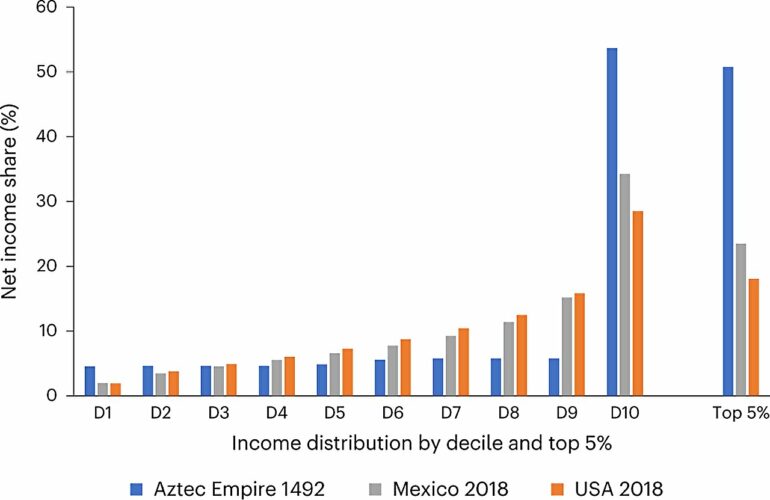Spanish conquerors did not themselves bring inequality to the Aztec lands they invaded, they merely built on the socio-economic structure that was already in place, adapting it as it suited their plans. This is the subject of an article by Guido Alfani of Bocconi’s Department of Social and Political Sciences and Alfonso Carballo of NEOMA Business School in France. Their article, “Income and inequality in the Aztec Empire on the eve of the Spanish conquest,” has just been published in Nature Human Behaviour.
Income distribution in present-day Mexico is, as in other Latin American countries, rather unequal. Alfani and Carballo started out from this well-known fact and began to investigate whether the situation was any different before Spanish rule replaced the so-called Aztec Empire. This polity originated from an alliance of three city-states which over time came to rule over a range of provinces which were required to pay tributes, including in blood. Its agriculture was fairly advanced in terms of yield, but extremely labor-intensive as the wheel was unknown and no animals were employed.
The primary social distinctions in the Aztec Empire were between the nobility, the commoners and the slaves. The elite dominated the commoners by holding exclusive control over resources. The taxes established for each province were variable, depending on how the province had become part of the Aztec Empire. Those provinces that had militarily resisted the Aztec Empire were subjected to higher imperial tax rates once conquered.
The main hurdle in assessing income levels for pre-Hispanic Mexico lies of course in the scarcity of relevant data: Aztec archives were extensively destroyed by Spanish troops and little usable information survives. The authors therefore estimated per capita income in the Aztec Empire by exploiting the variation in population density using archaeological data. They estimate that average per capita income on the eve of Spanish conquest was approximately US$690, which is significantly lower than contemporary Spain. This average conceals important differences between the cities and the rural areas.
Alfani and Carballo estimated that before the conquest the richest 1% earned 41.8% of the total income; this figure grows to 50.8% if the richest 5% is considered. As the income share of the poorest 50% was just 23.3%, this makes for a very skewed income distribution, actually even worse than today. The imperial ruling class, the provincial ruling class and the non-ruling nobles amounted to less than 2% of the total population but concentrated 46.6% of the total income.
This is extremely important because it helps explain how a little Spanish army of just a few hundred men could quickly overrun the Aztec Empire. The highly centralized tax collection was so resented by vast regions of the Empire that their populations, whose living standards were only slightly above subsistence, actually took arms on the Spaniards’ side.
“The rapacious institutions characterizing the Aztec Empire paved the ground for subsequent colonial exploitation,” says Guido Alfani. “As we argue, the relatively high levels of income inequality that came to characterize Latin America could not be considered to have been the sole consequence of the initial conditions imposed by the Spaniards. Nor could they simply come from the predatory attitudes and institutions of the colonial elite. Instead, colonization further exacerbated the highly extractive conditions that had come into being before the conquest and ensured their continuation for centuries thereafter.”
More information:
Guido Alfani et al, Income and inequality in the Aztec Empire on the eve of the Spanish conquest, Nature Human Behaviour (2023). DOI: 10.1038/s41562-023-01636-3
Provided by
Bocconi University
Citation:
Economic relationships in Pre-Columbian Mexico show that Aztec rulers were ruthless exploiters (2023, September 13)



